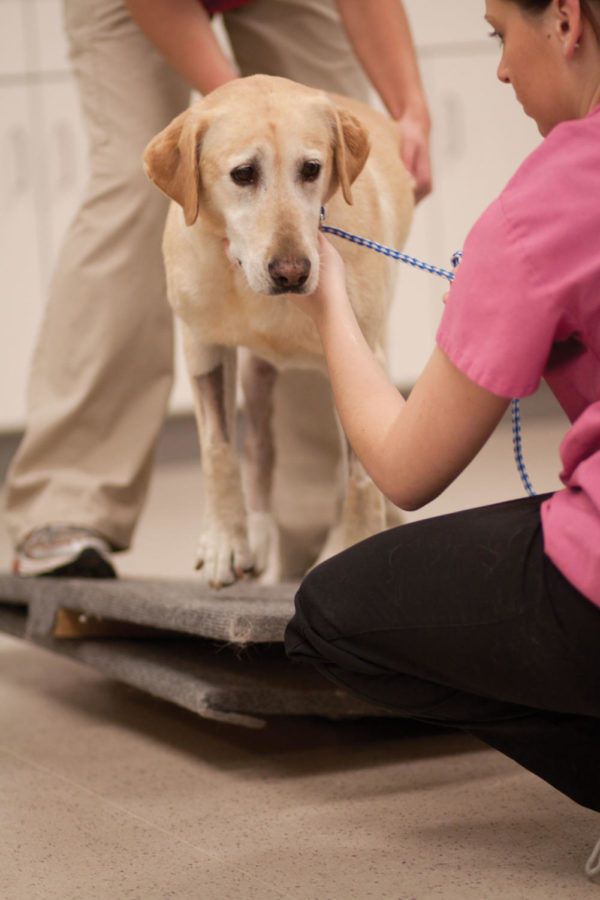Small Animal Hospital rehab center helps canines
Photo: Amber Hovey/Iowa State Da
Canines during a rehab therapy session at the Canine Rehab Center. Canine Rehab Center is at the small animal hospital at the college of Veterinary Medicine on November 1, 2011. Photo: Amber Hovey/Iowa State Daily. Two fourth year Veterinary Medical students doing a balancing exercise with Charlie. Charlie is a golden retriever who had knee surgery a week ago and is just starting therapy.
November 3, 2011
Lily is 5 years old and goes to rehab Monday through Friday. She suffers from a history of disease involving an issue with the discs that sit between the vertebrae. Partly because of this, Lily cannot walk by herself.
The unique characteristic about Lily, and other patients at this rehab clinic, is that they are furry with wet noses.
Dr. Mary Sarah Bergh, an orthopedic surgeon and director of Canine Rehabilitation at the Small Animal Hospital located at the College of Veterinary Medicine, said canine rehab is similar to human rehab in that the dogs “can’t talk, but they certainly let us know what’s wrong in other ways.”
At the Canine Rehab Center, dogs of all sizes and conditions are rehabilitated, giving them a chance for a speedy recovery as well as an “improvement in the quality of recovery and function,” Bergh said.
The majority of the patients are sent to rehab after orthopedic or neurologic surgery in order to recover, said Joanna Hildreth, a certified canine rehabilitation practitioner at the center. However, some dogs, like Lily, use rehab as an exercise program for problems such as obesity, arthritis or to help with pain relief.
“Rehab is an important aspect of overall animal health for cardiovascular and muscular conditioning and for maintaining and improving joint health,” Hildreth said.
Hildreth describes every dog as an individual and with that comes different therapy options.
For therapy, Lily usually does the underwater treadmill in the morning and then the balancing ball in the evenings, said a fourth-year veterinary medicine student who has been working with Lily.
The rehab center has many other rehabilitation exercises besides the ones mentioned for Lily, such as stairs, cavaletti rails, laser therapy and neuromuscular electrical stimulation.
The rehab center monitors progress of each patient by measuring muscle mass and range of motion in the joints and the dog’s ability to tolerate each activity, Bergh said. The center also uses force plates, which are able to measure how much weight the dog places on each foot.
“I want to give every opportunity to her,” said Lori Adams, Lily’s owner, “She’s like a child, part of the family.”
Adams and Hildreth both said they’ve noticed a positive difference in Lily since she started coming to rehab.
The people at the rehab center “treat my dog like it’s their own,” Adams said. They provide “great attention” and ‘great therapy.”
“I can’t say enough good things,” Adams said.







